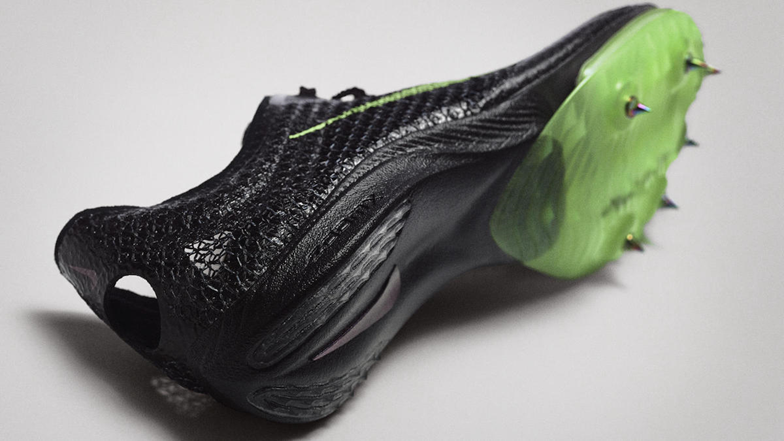
Charles R. Goulding and Preeti Sulibhavi examine the use of 3D printing in competitive running shoes from Nike.
Nike has always been on the cutting edge of shoe technology. “Just do it” is not something they say lightly. In fact, Nike has been utilizing advanced technologies, like 3D printing, for quite some time now. We have reported previously on Nike’s advanced sneaker technology and how it has impacted the Olympics in previous years.
Nike is not the only shoe/sneaker company jumping on the 3D printing bandwagon. Puma has been using 3D printing in some of its collections of mechanical foam cushioning shoes as well. Crocs has utilized 3D printing to make its footwear even more comfortable and stylish than ever.
Nike
The multinational corporation responsible for the design, development and mass production of footwear, apparel, equipment, accessories and services has been transforming the industry with the help of 3D printing.
In 2013, Nike released the Nike Vapor Laser Talon. It is the world’s first-ever soccer cleat fabricated with 3D printing technology. Using selective laser sintering (SLS) to produce the cleat, the shoe weighed a slight 156 grams and was designed to help athletes maintain optimal traction on soccer turf. In 2016, Nike invested in additive manufacturing through a partnership with HP, the developer of Multi Jet Fusion technology. As a result, Nike developed the 3D printed track spike, the Nike Zoom Superfly Flyknit.
In 2017, Nike developed the Nike Zoom Vaporfly Elite, which was worn by Eliud Kipchoge in that year’s Berlin Marathon. With some adjustments and improvements, 2018 saw Kipchoge break records wearing the Nike Flyprint (the modified version of the Vaporfly Elite).

Since then, the developmental shift for Nike has been from 3D printing prototypes to additively manufacturing products.
Nike Spikes
Like the Vaporfly, the Nike Spikes are digging into the competition – and winning. A recent Wall Street Journal article featured the shoe technology that is revolutionizing marathons globally. Just last month, Dutch runner Sifan Hassan smashed the women’s 10,0000-meter record by 10 seconds. Not long after, Ethiopian runner Letesenbet Gidey broke the 10,000-meter record by 15 seconds wearing the Nike Super Spikes.

The Athlete or the Shoe?
While Vaporfly enthusiasts highlight the beneficial qualities of the shoe, critics raise concerns over the added advantage. Critics in the racing community contend that the shoe is a type of “mechanical doping,” and that the improved running efficiency that comes with the shoe also comes with a high price tag. They argue that running should not be about who has the best technology, but about the endurance of the athlete.
In these innovative, technological times, integrating athletics with technology may be an inevitable outcome that pushes the boundaries of technology as well as those of athletes. This technology may also help to minimize injuries sustained by athletes, which is an added plus.
These shoes are designed for athletes to shatter records and help them win medals. The question becomes is it wrong to push the boundaries of athletes as well as that of technology? The same human endurance argument could have been made generations ago when sneakers were just emerging as a new type of athletic shoe. That argument did not win then and may not now.
The Research & Development Tax Credit
The now permanent Research and Development (R&D) Tax Credit is available for companies developing new or improved products, processes and/or software. Eligible costs include U.S.-based employee wages, cost of supplies consumed in the R&D process, cost of pre-production testing, contract research expenses, and certain costs associated with developing a patent. As of 2016, eligible startup businesses can use the R&D Tax Credit against $250,000 per year in payroll taxes.
3D printing can help boost a company’s R&D Tax Credits. Wages for technical employees creating, testing and revising 3D printed prototypes can be included as a percentage of eligible time spent for the R&D Tax Credit. Similarly, when used as a method of improving a process, time spent integrating 3D printing hardware and software counts as an eligible activity. Lastly, when used for modeling and preproduction, the costs of filaments consumed during the development process may also be recovered.
Whether it is used for creating and testing prototypes or for final production, 3D printing is a great indicator that R&D Credit eligible activities are taking place. Companies implementing this technology at any point should consider taking advantage of R&D Tax Credits.
Race to the Finish
Nike has proven, by example, what 3D printing can do to design and develop innovative products. With the summer Olympics upon us, this is an opportunity for 3D printing to enter the athletic shoe game.
